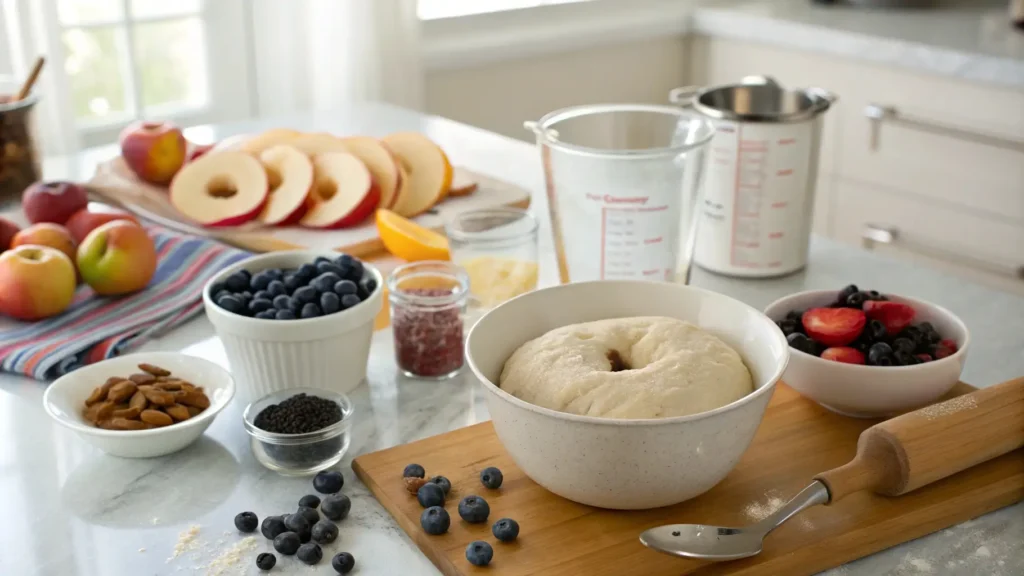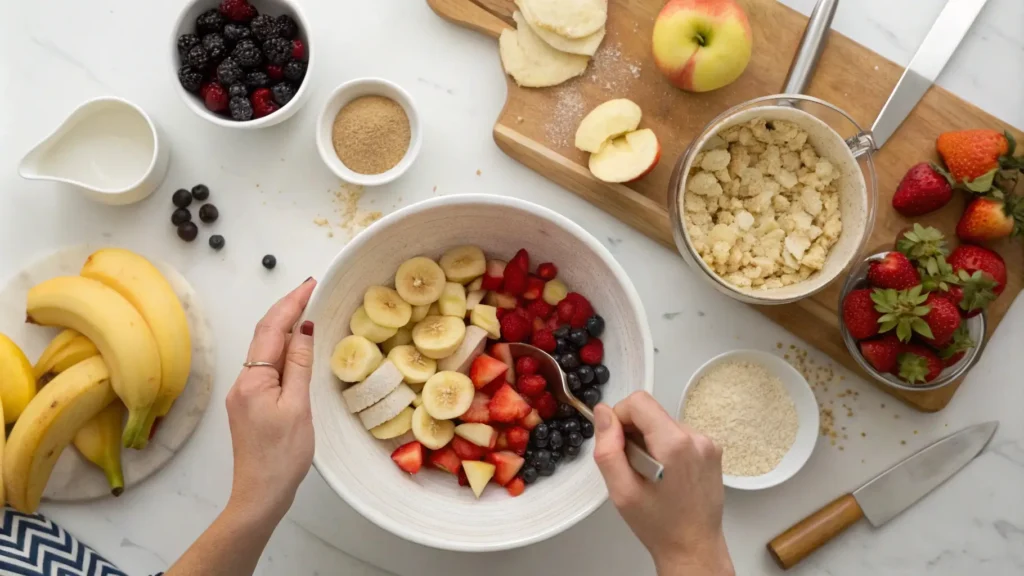Adding fruit to bagel dough can transform ordinary bagels into delicious, flavorful treats bursting with texture and sweetness. However, the process isn’t as simple as tossing in a handful of fruit—it requires careful timing, preparation, and technique to avoid issues like soggy dough or uneven distribution. This article dives deep into when to add fruit to bagel dough and how to ensure your bagels turn out perfectly every time. From choosing the right fruit to adjusting baking times, we’ve got you covered with all the tips and tricks needed to master fruited bagels. Let’s start by exploring the basics!

Understanding the Basics of Adding Fruit to Bagel Dough
What Makes Fruited Bagels Unique?
Fruited bagels bring a delightful twist to the classic plain bagel, combining chewy dough with bursts of sweetness and texture. Whether it’s dried fruits like raisins or apricots or fresh options like blueberries, the added flavors elevate your baking game. But there’s a catch—fruit can add moisture or break apart, affecting the dough’s structure. That’s why understanding the essentials of fruit selection and preparation is vital to creating bagels that are flavorful and well-balanced.
What makes these bagels special isn’t just their flavor; it’s their versatility. Fruited bagels pair wonderfully with spreads like cream cheese, butter, or even honey, making them perfect for breakfast or a midday snack. When prepared correctly, the fruit enhances the bagel’s taste without overpowering the dough’s natural texture.
Types of Fruit Commonly Used in Bagel Dough
When considering what fruit to add to bagel dough, dried fruits are the top choice for many bakers. Options like raisins, cranberries, and chopped apricots work best because they don’t release excess moisture, which can make the dough sticky or difficult to handle. Plus, they maintain their shape during baking, ensuring even distribution.
Fresh fruits, on the other hand, offer a vibrant burst of flavor but require extra care. Blueberries, diced apples, and chopped strawberries are popular options, but their higher moisture content can complicate the process. To make these work, it’s crucial to pat them dry and lightly toss them in flour before mixing them into the dough. This helps prevent clumping and sinking, ensuring a consistent bake.
When choosing fruit, consider its flavor profile. Sweet fruits like raisins or dried cherries add a touch of natural sugar, while tart options like cranberries bring balance. If you’re feeling adventurous, try mixing fruits—like raisins and dried apricots—for a unique flavor combination.
The Ideal Time to Incorporate Fruit into Bagel Dough
Why Timing Matters
When it comes to baking, timing is everything—especially when adding fruit to bagel dough. Introducing fruit at the wrong stage can throw off the dough’s structure, leaving you with uneven textures or soggy spots. The dough’s gluten structure, which gives bagels their signature chewiness, needs time to develop fully before handling any add-ins like fruit. If you add it too early, the fruit can interfere with this process, making the dough weak or sticky.
Moreover, waiting too long to add the fruit can lead to a struggle during shaping. At this point, the dough might already be stiff, making it harder to incorporate the fruit evenly. This is why knowing when to add fruit to bagel dough is key to achieving perfectly balanced, flavorful bagels.
When Is the Right Moment?
The best time to add fruit to bagel dough is during the final kneading phase. After the dough has been mixed and had its first rise, it’s ready for the fruit. By this stage, the gluten has developed enough to support the extra weight of the fruit without collapsing or becoming sticky.
To incorporate the fruit effectively, gently fold it into the dough rather than kneading aggressively. This ensures even distribution without crushing the fruit, especially delicate fresh options like blueberries. Handling the dough carefully at this point also preserves the dough’s elasticity, which is essential for shaping bagels.
Not sure if your dough is ready? Look for signs like a smooth, elastic texture and a slightly risen appearance. With this timing and technique, your dough will hold its shape beautifully, even with the added fruit.
Preparing Fruit for Bagel Dough

Prepping Dried Fruits
Dried fruits are a favorite for fruited bagels because they’re low in moisture and easy to work with. But even these need a bit of preparation before being added to the dough. Start by soaking the dried fruit in warm water or juice for a few minutes to plump it up. This helps prevent the fruit from becoming overly chewy or dry during baking. However, don’t skip the next step: patting the fruit dry. Excess moisture can make your dough sticky and difficult to handle.
Another essential step is checking for sugar coatings on dried fruits like raisins or cranberries. These can caramelize too quickly during baking, potentially burning the fruit. Rinse off any sugary coatings, then dry the fruit thoroughly before mixing it into your dough.
Preparing Fresh Fruits
If you’re opting for fresh fruit, the preparation process is slightly different but just as important. Fresh fruits like blueberries or diced apples can add a natural sweetness and vibrant flavor, but their moisture content needs to be managed carefully. To prevent these fruits from making the dough too wet, toss them lightly in flour before incorporating them. This thin coating of flour absorbs excess moisture and helps the fruit stay evenly distributed throughout the dough.
For fruits with high water content, like strawberries or peaches, consider patting them dry with a paper towel after slicing. Smaller, uniform pieces work best, as they’re less likely to break apart during mixing and baking.
By taking the time to prepare your fruit—whether dried or fresh—you’ll ensure it integrates seamlessly into the dough, keeping the texture and flavor just right. It’s a small step that makes a big difference when you’re figuring out when to add fruit to bagel dough.
Step-by-Step Process for Adding Fruit to Bagel Dough
Mixing the Dough First
Before adding fruit, it’s crucial to prepare your dough properly. Begin by mixing your base ingredients—flour, yeast, salt, and water—until a smooth and elastic dough forms. Allow the dough to rise fully during the first proofing stage. This ensures the gluten has developed enough to handle the addition of fruit without tearing or weakening.
During this stage, focus on consistency. A properly kneaded dough should be firm yet pliable, holding its shape while allowing for gentle folding. Rushing this step can result in uneven texture, making it harder to achieve that signature chewy bagel structure.
If you’re curious about other bagel variations, check out this helpful Blueberry Bagel Recipe for inspiration. It’s packed with tips for incorporating fruit into bagels!
Incorporating Fruit Safely
When deciding when to add fruit to bagel dough, timing and technique are key. Once your dough has risen and is ready for the final kneading phase, it’s time to fold in the fruit. Use a light hand and follow these steps:
- Flatten the Dough: Lightly press the dough into a rectangle on a floured surface.
- Add the Fruit: Scatter your prepared fruit evenly across the dough. Whether you’re using dried raisins or fresh blueberries, aim for even coverage to avoid clumps.
- Fold and Turn: Gently fold the dough over the fruit, pressing lightly. Turn the dough and repeat the process until the fruit is distributed evenly. Be careful not to overwork the dough, as this can crush the fruit and make the dough sticky.
Once the fruit is fully incorporated, shape the dough into bagels as usual. By maintaining a delicate touch, you’ll keep the dough elastic and the fruit intact.
Adjusting Bake Times and Techniques for Fruited Bagels
How Fruited Bagels Differ in the Oven
Fruited bagels often require slight tweaks to baking times and temperatures compared to plain bagels. The natural sugars in fruit—especially fresh or dried options like raisins or apples—tend to caramelize quickly, leading to browning. While this creates a delicious flavor, it can also cause the fruit to scorch if not managed carefully.
One trick to prevent burning is to lower the baking temperature slightly, extending the baking time to ensure even cooking. Keep an eye on the bagels as they bake, looking for a golden-brown crust and evenly cooked surface. If your fruit pieces are exposed on top, covering the bagels lightly with foil during the final few minutes can help prevent charring.
Optimal Bake Times and Temperatures
For best results, bake your fruited bagels at around 375°F (190°C) instead of the typical 400°F. This lower temperature reduces the risk of burnt fruit while giving the dough enough time to cook through. Expect bake times of 20–25 minutes, though this can vary based on the size and moisture content of the bagels.
Tap the bottom of a baked bagel to check for doneness—it should sound hollow. Additionally, ensure the fruit looks plump and caramelized but not overly browned. With these adjustments, your bagels will come out perfectly cooked, with every bite delivering a balanced mix of sweetness and chewiness.
Enhancing the Flavor of Fruited Bagels

Adding Spices and Flavor Pairings
To truly elevate your fruited bagels, consider enhancing their flavor with the right spices. Warm spices like cinnamon, nutmeg, or allspice complement the natural sweetness of fruits like raisins, blueberries, or apples. These spices add depth and balance, making every bite more complex and satisfying.
When incorporating spices, mix them into the dry ingredients before adding water and yeast. This ensures even distribution throughout the dough, creating a consistent flavor profile. For instance, a pinch of cinnamon paired with dried cranberries can give your bagels a festive twist, while nutmeg enhances the richness of raisin-studded bagels.
Vanilla extract or a hint of citrus zest can also add subtle brightness to your bagels. Don’t be afraid to experiment with combinations to find a blend that complements the fruit you’re using. The goal is to create layers of flavor without overwhelming the natural taste of the fruit.
Combining Fruits for Variety
For a truly unique bagel, mix different types of fruits into your dough. A blend of raisins and dried apricots, for example, provides a mix of sweetness and tartness, while pairing fresh blueberries with diced apples gives your bagels a refreshing burst of flavor.
When mixing multiple fruits, be mindful of proportions to avoid overloading the dough. Too much fruit can make it harder to handle and may lead to uneven baking. Stick to about 1/2 to 3/4 cup of fruit per batch of dough to maintain balance.
Remember, knowing when to add fruit to bagel dough is just as important as selecting the right combinations. Add your fruit at the final kneading stage to preserve its texture and ensure even distribution.
Storing Fruited Bagels for Maximum Freshness
Best Practices for Short-Term Storage
Proper storage is essential to keep your fruited bagels fresh and flavorful. Once cooled, store them in an airtight container or resealable plastic bag at room temperature for up to two days. This prevents the bagels from drying out while protecting them from external moisture.
Avoid refrigerating your bagels, as this can make them go stale faster. If you need to extend their shelf life, freezing is a better option.
Freezing Fruited Bagels
To freeze your bagels, wrap each one tightly in plastic wrap and place them in a freezer-safe bag or container. This keeps the bagels from absorbing any freezer odors while preserving their texture. When you’re ready to enjoy them, thaw the bagels at room temperature or warm them in the oven for a few minutes.
Freezing is particularly useful for fruited bagels because it helps lock in their moisture and flavor. Whether you’ve made a batch of cranberry-orange bagels or blueberry-studded ones, proper storage ensures they’ll taste just as fresh as the day they were baked.
For more baking tips, consider checking out a recipe like the Blueberry Bagel Recipe to see how proper storage can extend the life of your homemade creations.
FAQs: Common Questions About Fruited Bagels
What Types of Fruit Are Best for Bagel Dough?
When choosing fruit for bagel dough, dried fruits like raisins, cranberries, and apricots are some of the best options. They’re easy to work with because they don’t release moisture that could disrupt the dough’s structure. For a different twist, consider dried cherries or chopped dates.
Fresh fruits like blueberries or diced apples are also fantastic but require extra care. To prevent these fruits from adding too much liquid to your dough, make sure to dry them thoroughly and toss them lightly in flour before adding them. The key to success lies in knowing when to add fruit to bagel dough—always during the final kneading stage to ensure even distribution without compromising the dough’s texture.
Can Frozen Fruit Be Used in Bagel Dough?
Yes, frozen fruit can be used, but there’s a trick to making it work. Always thaw frozen fruit completely and pat it dry with a paper towel to remove any excess moisture. Adding wet fruit to your dough can make it sticky and difficult to handle.
To avoid crushing the fruit while mixing, fold it in gently during the last kneading step. This timing is essential for maintaining the dough’s structure and preventing the fruit from sinking or clumping. Once you’ve mastered when to add fruit to bagel dough, using frozen fruit becomes an easy way to experiment with seasonal flavors year-round.
How Do I Prevent Fruit From Sinking or Burning?
Fruit sinking or burning is a common challenge in bagel-making. To prevent this, toss your fruit in a light coating of flour before mixing it into the dough. The flour helps the fruit stick to the dough, keeping it evenly distributed as you shape and bake your bagels.
For fruits that tend to scorch during baking, like raisins or blueberries, consider lowering the oven temperature slightly or placing a piece of foil over the bagels during the last few minutes of baking. These simple adjustments ensure that your bagels bake evenly without compromising flavor or texture.
Can I Add Nuts or Seeds Alongside Fruit?
Absolutely! Combining fruits with nuts or seeds adds extra texture and flavor to your bagels. For example, walnuts pair beautifully with dried cranberries, while sunflower seeds add a delightful crunch to blueberry bagels.
To avoid overwhelming the dough, stick to the recommended quantity—around 1/2 to 3/4 cup of total add-ins per batch. Add nuts and seeds at the same time as the fruit, during the final kneading phase, to ensure even distribution.
By addressing these FAQs, you’ll have a solid understanding of when to add fruit to bagel dough and how to perfect every batch. With a bit of practice and creativity, you can make delicious, bakery-quality fruited bagels at home. Happy baking!

